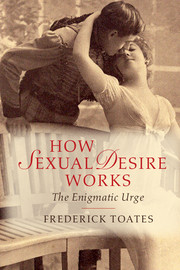Book contents
- Frontmatter
- Dedication
- Contents
- List of figures
- Preface
- One What is enigmatic about sexual desire?
- Two Explaining desire: multiple perspectives
- Three Sexual desire in a broad context
- Four An incentive-based model
- Five Sex and levels of organization
- Six Sexual attraction
- Seven Shades of desire from simple to complex
- Eight Details of the brain and desire
- Nine Arousal
- Ten The consequences of sexual behaviour and associated expectations
- Eleven Sexual familiarity and novelty
- Twelve Inhibition, conflict and temptation
- Thirteen How did sexual desire get here?
- Fourteen Setting the trajectory: link to adult sexuality
- Fifteen Sexual desire in interaction
- Sixteen Representations of sex
- Seventeen Sexual addiction
- Eighteen Variations in desire: general principles
- Nineteen Some forms of desire at the fringes
- Twenty The toxic fusion: violence and sexual desire
- Twenty one Sexually associated (serial) murder
- Twenty two Concluding remarks
- Notes
- References
- Index
One - What is enigmatic about sexual desire?
Published online by Cambridge University Press: 05 October 2014
- Frontmatter
- Dedication
- Contents
- List of figures
- Preface
- One What is enigmatic about sexual desire?
- Two Explaining desire: multiple perspectives
- Three Sexual desire in a broad context
- Four An incentive-based model
- Five Sex and levels of organization
- Six Sexual attraction
- Seven Shades of desire from simple to complex
- Eight Details of the brain and desire
- Nine Arousal
- Ten The consequences of sexual behaviour and associated expectations
- Eleven Sexual familiarity and novelty
- Twelve Inhibition, conflict and temptation
- Thirteen How did sexual desire get here?
- Fourteen Setting the trajectory: link to adult sexuality
- Fifteen Sexual desire in interaction
- Sixteen Representations of sex
- Seventeen Sexual addiction
- Eighteen Variations in desire: general principles
- Nineteen Some forms of desire at the fringes
- Twenty The toxic fusion: violence and sexual desire
- Twenty one Sexually associated (serial) murder
- Twenty two Concluding remarks
- Notes
- References
- Index
Summary
Consider the time, I hope recently, when you saw a woman or man (fill in your preference) who awoke in you, within a matter of seconds, a distinct state of lust…The object of origin for that awakening presented itself, in all its glory, probably not whole but in parts. Maybe what first arrested your attention was the shape of an ankle, how it connected with the back of a shoe and how it dissolved into a leg, no longer seen but just imagined, under a skirt….Or maybe it was the shape of a neck sticking up from a shirt. Or maybe it was not a part at all but the carriage, moves, energy, and resolve that propelled a whole body forward.
(Damasio, 2003, p. 93)It would be informative to discover how Damasio’s readers (and indeed mine too) have reacted to this invitation to reflection. If they are like the population sampled by sex researchers, some would find it hard to recall any such lust-filled moments, whereas others would be inundated with recent memories jockeying for occupation of the conscious mind. Some would doubtless find their desire triggered instantly by such parts of the whole as an ankle or leg, whereas a number might find it fuelled by the shoes worn. Others would only be excited slowly by a whole speaking and socially interacting personality.
The enormous variation in the reactivity of human sexual desire is why I use the term ‘enigma’ and is a feature that must be accommodated by any attempt to explain desire’s foundations. What are the implications of this wide spectrum of responses? Is there a healthy norm, while deviations to either side indicate that something is wrong? Accounts by individuals, both famous and not, on their experience of desire are invaluable in understanding how it works and they will be used widely throughout the following pages.
- Type
- Chapter
- Information
- How Sexual Desire WorksThe Enigmatic Urge, pp. 1 - 28Publisher: Cambridge University PressPrint publication year: 2014

